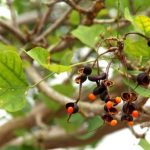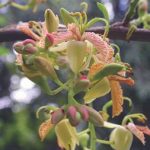TREE LIFE
August 2008
MASHONALAND CALENDAR
17 August (3rd Sunday): Visit to Ewanrigg. This month’s outing is to Ewanrigg. Quite apart from the gardens, which contain many interesting cultivated plants, this is also an interesting place for indigenous trees.
Directions: Take the Enterprise Road out of Harare, turn left to Shamva at the 21km junction and continue along this road till you see the Ewanrigg sign to the right. We will meet in the open area in the farthest part of Ewanrigg. To get there, bear left after entering the main gate and continue to the end.
There will be an entrance fee – so please bring some money. We will meet at 9.30 a.m. Allow about ¾ hour travelling time.
PLEASE NOTE: There will be no 4th Saturday walk on the 23rd of this month.
MATABELELAND CALENDAR
Please contact Jean Wiley or Gill Short for details of the next Matabeleland function.
African ‘wall of trees’ gets underway
The ‘Great Green Wall’ of trees will involve several stretches of trees from Mauritania in the west to Djibouti in the east, as this story from the Science and Development Network relates. Three years after it was first proposed, preparations for an African ‘wall of trees’ to slow down the southwards spread of the Sahara desert are finally getting underway. The Great Green Wall will involve several stretches of trees from Mauritania in the west to Djibouti in the east, to protect the semi-arid savannah region of the Sahel — and its agricultural land — from desertification.
A plan for the proposed US$3 million, two-year initial phase of the project — involving a belt of trees 7,000 km long and 15 km wide — was formally adopted at the Community of Sahel–Saharan States (Cen-Sad) summit on rural development and food security in Cotonou, Benin, in June this year. North African nations have been promoting the idea of a Green Belt since 2005. The project has been scaled down to reinforce and then expand on existing efforts, and will not be a continent-wide wall of trees, despite the name of the project. The Green Wall will involve two planting projects—one each on the east and west sides of Africa.
The Inter-State Committee for Drought Control in the Sahel region (CILSS) is working with scientific consultants and representatives from the arid nations of Burkina Faso, Mali, Mauritania, Niger, Nigeria and Senegal to launch pilot planting projects planned for September.
Another planting programme, including Chad, Djibouti, Eritrea, Ethiopia and Sudan, should be finalised within two months under the auspices of six states in the Horn of Africa, linked through the Intergovernmental Authority on Development (IGAD).
Mariam Aladji Boni Diallo, the Benin-based president of the Cen-Sad summit organising committee, says she hopes the Green Wall will consist of more than just trees. Diallo told SciDev.Net that “reforestation, restoration of natural resources and the eventual development of fishing and livestock breeding” were priorities for the project. However, she said that funding for the project was still tentative.
The UNESCO-linked non-profit Observatory of the Sahara and the Sahel has prepared a report on the project, saying the labour-intensive project should be used to create employment but advising that payments be partly withheld for two years until the trees were established, and that payment be based on plant growth.
Joséa Dossou Bodjrènou, head of the Nature Tropicale environmental education organisation at the Museum of Natural Science in Benin, warned that the project can only be assessed once it stops being words on paper and becomes action. “The population needs to be sensitised to the importance of planting trees and taking care of them. Otherwise, they would destroy them without knowing it’s dangerous for the ecosystem. All this work would lead to nothing,” Bodjrènou, told SciDev.Net.
“It’s really important for the work to be done with local experts in each country because they know which species can grow on their soil. And we have to use local species, not imported ones.”
Alien Invasive Species:
Their Impacts on Forests and Forestry [This is the second and concluding part of the review of the impact of alien invaders on forests and forestry. Again, the complete original version of the paper can be found at: https://www.fao.org/docrep/008/j6854e/J6854E00.HTM.
–Ed.]
Positive impacts of introduced woody species on forests and forestry
The forest sector often depends on introduced species to provide a variety of socio-economic, environmental and human health benefits to forestry and to the rural communities that depend upon forests. Many introduced species are highly regarded because of their exceptional adaptability to a wide variety of sites, their rapid growth, and the multiple uses of their products.
With growing concerns about the degradation and loss of natural forests, planted forests and trees outside forests, composed most often of introduced woody species, are becoming increasingly more important sources of products such as timber, fibre and fuelwood. In developing countries, fuelwood is the prime source of energy, representing over 80 percent of the wood harvest. Planted forests also provide non-wood forest products, such as fruits, leaves, roots, honey, fibres, oils, resins, cosmetics and medicines, either from the planted trees themselves or from other elements of the ecosystem that they help to create. Such products contribute to the livelihoods of rural communities by providing food, medicine and employment as well as income from their sale. In countries with low forest cover, planted forests and trees outside forests constitute the main source of wood and non-wood forest products.
In addition to providing valuable forest products, alien tree species planted in forest plantations and other areas help provide many vital ecosystem services such as:
• combating desertification;
• protecting soil and water;
• rehabilitating lands exhausted from other land uses;
• diversifying the rural landscape;
• maintaining biodiversity;
• enhancing carbon sequestration; and
• providing amenity and shade.
When planted in riparian areas, trees provide spawning beds for fish and molluscs and shade which aids in the reduction of eutrophication. Trees planted on farms help to increase soil fertility by providing organic matter through litter decomposition at the soil surface or through atmospheric nitrogen fixation (nitrogen-fixing trees), both of which contribute to improvements in food production. Along roads and highways, trees and plants not only add beauty to cities and towns but also provide shade and control outdoor noise and traffic pollution. Trees also play a major role in preserving the social and cultural values attached to forests, particularly as natural forests decrease in size through deforestation or are designated for other purposes.
The forest sector also employs introduced species in biological control programmes to help combat pest problems with considerable success. Practical reasons for using introduced species instead of native species in the forest sector include the following:
• Introduced trees often grow much faster than native species, particularly in the first years after planting.
• Native species are more difficult to manage silviculturally, in part because the biology of these species—information on how to collect, store and germinate seeds, how to produce seedlings in a nursery and how to manage them in a forest—is often poorly understood. Introduced species, on the other hand, have been well studied in a variety of settings.
• Seeds from introduced species are more readily available and easier to handle than seeds of native tree species.
• In order to reduce the need for imported wood products, it is often necessary to develop local forest industries. Knowledge of markets and manufacturing technology is more readily available for introduced species such as pines and eucalypts.
Positive impacts may be best achieved by careful selection of species and risk assessment prior to introduction and large-scale planting, coupled with management of introduced species in order to prevent them from becoming invasive.
Negative impacts of alien invasive species on forests and forestry
Alien invasive species negatively impact the forest sector in economic, ecological and environmental, and social and health terms, though these impacts are almost never mutually exclusive.
Economic
Alien invasive species generate substantial costs to the forest sector in lost revenues in expenses for their control and in lost conservation values and ecosystem services. Alien invasive species, in particular insect pests and diseases, can damage trees in all stages of development and affect the ability of both natural and planted forests to meet their management objectives.
The most direct economic impact of alien invasive species on the forest sector is related to the loss or reduced efficiency of production. Approximately US$4.2 billion in forest products are lost each year to alien insect pests and pathogens in the United States. In Canada, the damage resulting from past introductions of harmful invasive plant pests on agricultural crops and forestry has been estimated at C$7.5 billion annually. In the Canadian province of Manitoba alone, economic losses due to Dutch elm disease (Ophiostoma ulmi sensu lato) have been estimated at approximately C$30 million. The detection of Asian longhorned beetle (Anoplophora glabripennis) in Canada poses a significant threat to both the hardwood products industry and the maple syrup industry, whose products were valued in 1997 at C$480 million and C$130 million respectively. Such infestations of alien invasive species directly affect the quantities of forest products demanded or supplied thereby impacting global prices and markets. Although quantitative estimates of the economic impacts are not readily available for other countries, alien invasive species no doubt significantly impact productivity.
Possibly outweighing direct production costs, the introduction and spread of alien invasive species can have major implications for trade that will depend on the policy response of trading partners to news about outbreaks, the importance of the traded commodities, the extent of the damage, and the nature of demand and supply.
In addition to these direct production and trade costs, the associated control costs, including the costs of inspections, monitoring, prevention, and response, of even just a few species can be enormous. The United States Forest Service currently spends approximately US$11 million annually on control of the gypsy moth (Lymantria dispar), a major pest of forest and ornamental trees. Removal of elm trees affected by Dutch elm disease (Ophiostoma ulmi sensu lato) costs approximately US$100 million per year. In South Africa, the cost of controlling alien plant invasions has been estimated to be approximately US$1.2 billion—although some have challenged this estimate.
Ecological and environmental
The full economic costs of invasions include not only the direct damage and control costs but also the effects on the ecosystems themselves. The ecological and environmental impacts of alien invasive species can be felt at all levels—from the gene, through species and habitats, to the ecosystem.
Genes. If introduced or spread into habitats with closely related species, alien invasive species could interbreed with native species, resulting in changes to the genetic makeup of either species. The possible negative consequences of such alterations include reduction in the survival of either species, creation of a more successful invader, or the creation of hybrids that could be more susceptible to certain pests and pathogens. Of recent concern to the forest sector is the impact of possible introduction of new tree genotypes (non-local provenances or genetically improved planting stock) resulting in the creation of hybrids and the resulting loss of gene pools that may have acquired specific characteristics through local adaptation. The issue has not been extensively studied in forest trees, except possibly in the European black poplar (Populus nigra).
Species. Alien invasive species can influence species diversity, richness, composition and abundance. At the species level, direct effects of alien invaders occur through processes such as the predation of, competition with, and pathogen and parasite transmission to individual organisms, eventually leading to population declines and species extinctions.
Through direct impacts on species or through alterations of habitats, alien invasive species are—according to the IUCN—responsible for placing 762 forest species at risk. The loss of such species is leading to a more homogenous world that is perhaps the second biggest threat to global biological diversity after habitat loss.
Some examples of species-level impacts in forests include the following:
• Miconia (Miconia calvescens), a tropical American tree introduced to French Polynesia in 1937, has significantly altered the forests of French Polynesia and other Pacific islands by shading out all native plants and promoting erosion and landslides with its shallow roots.
• The invasive weeds, Scotch broom (Cytisus scoparius) and gorse (Ulex europaeus), are repressing the regrowth of the commercially important Douglas fir (Pseudotsuga menziesii) in British Columbia, Canada.
• The Asian shrub, Amur honeysuckle (Lonicera maackii), has invaded many eastern North American areas where it impacts the natural regeneration of forests by reducing tree seedling density and growth and fecundity of perennial forest herbs.
Habitats. Through their impacts on species and ecosystem processes, alien invasive species can result in the fragmentation, destruction, alteration or complete replacement of habitats, impacts which in turn have cascade effects on even more species and ecosystem processes. Some examples of these impacts in forests include the following:
• Alien invasive diseases and pests have caused major changes in the composition of forests in eastern North America over the past century, including the decline of species like chestnut, elm and hemlock.
• The direct impacts of an invasion of the hemlock woolly adelgid (Adelges tsugae) and the indirect impacts of the removal of the infested trees in hemlock-dominated forests included profound changes in structure, composition and ecosystem function. The loss of hemlock trees in these forests also resulted in significant changes in the composition and distribution of bird populations.
• When alien invasive insect species threaten native insect species, they can also have cascading effects on insectivorous birds and on plants that rely on insects for pollination or seed dispersal.
Ecosystems. The impacts of alien invasive species at the ecosystem level include changes to trophic structures, changes in the availability of resources such as water and nutrients, and changes in the disturbance regimes. Some examples of the impacts of alien invasive species on forest ecosystems include the following:
• Invasive alien plants and trees have decreased water supplies for nearby communities and increased fire hazards in South Africa.
• Invasive grasses that are particularly fire-prone may lead to a permanent loss of forests.
• Australian Acacia species, such as A. cyclops and A. saligna, have radically altered nutrient cycling regimes in nutrient poor ecosystems due to their ability to fix atmospheric nitrogen.
Social and health
The full costs of invasions also include the social and health impacts of alien invasive species on humans, in particular to the rural communities dependent on forests.
As a result of the negative impacts of alien invasive species on native forest biodiversity, a loss of food sources and traditional medicines may be experienced, thereby compromising not only the health of local people but also the livelihoods of those dependent on the collection and sale of such items for income. For small-scale landowners, alien invasive species can also decrease the value of their land.
Forest workers, as part of their jobs, and people living in and around forests are more exposed to alien invasive species, such as the reservoirs and hosts of many emerging infectious diseases. Examples of such diseases include Lyme disease, human immunodeficiency virus (HIV), Ebola and Marburg haemorrhagic fevers, malaria, yellow fever, leishmaniasis, trypanosomiasis and Kyasanur forest disease.
People living in and around invaded forest areas may also suffer allergic or other negative reactions to the alien invasive species themselves or to the measures used to control them, such as chemical and biological pesticides. A tree commonly planted for land restoration and as a source of forest products, mesquite is a major cause of allergies in India, Kuwait, Mexico, Saudi Arabia
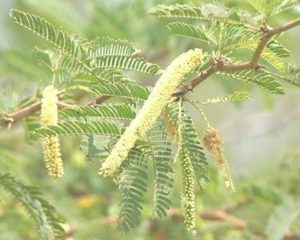
P. juliflora inflorescences and leaves, Krishna Wildlife S
South Africa, the United Arab Emirates and the south-western United States. Sensitivity to mesquite pollen has been shown to result in asthma, rhinitis and conjunctivitis. In Mongolia, children living close to areas infested with Dendrolimus sibiricus have experienced significant allergic reactions to the hairy caterpillars that have entered their homes. The hairs on larvae and egg masses of gypsy moth (Lymantria dispar) also cause allergies in some people. In the United States, forest workers working in areas heavily infested with the tussock moth caterpillar (Orgyia pseudotsugata) have experienced itching of the skin and eyes, nasal discharge, cough and respiratory difficulty.
Estimating the costs of alien invasive species
Estimates of the full costs of biological invasions are rare because of the difficulty in approximating the costs of a problem with so many components, many of which are difficult if not impossible to quantify—such as the impacts of alien invasive species on biodiversity, ecosystem functions, human health and other indirect costs such as the impacts of control measures.
A few attempts at estimating the costs of alien invasive species have been made. In 2005, it was estimated that the 50 000 alien species in the United States cost almost US$120 billion in environmental damages and losses yearly, while a 2000 estimate was even higher—at US$137 billion per year.
An examination was made of the over 120 000 alien species of plants, animal and microbes that have invaded Australia, Brazil, India, South Africa, the United Kingdom and the United States, causing significant economic losses in agriculture and forestry and negatively affecting ecosystems. The estimated total cost in the six countries was US$314 billion in damages per year—Australia $13 billion, Brazil $50 billion, India $116 billion, South Africa $7 billion, the United Kingdom $12 billion, and the United States $116 billion.
It has been concluded that about 4 500 exotic species occur in the United States and that about 20 percent of these have caused serious economic and environmental harm. The cumulative loss caused by 79 of these species was estimated at almost US$97 billion for the period 1906 to 1991.
While these estimates do not take all components into account, they nonetheless illustrate the enormity of the costs of alien invasive species.
Conflict species
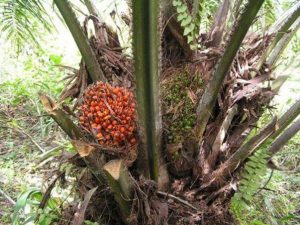
oil palm Elaeis guineensi, fruit. Photo: Wikiedia
While many introduced species are highly regarded because of the benefits they can provide, these same species have in some cases become serious threats to forests and the forest sector. Such conflict species are a considerable problem from a management perspective and require a clear and unbiased analysis of the costs and benefits of their use.
Some examples of conflict species include the following:
• Many species of Australian Acacia have been introduced into the Cape Floristic Region of South Africa for timber, fuelwood and building materials (A. mearnsii); for tannins which are used by leather industries (A. saligna, A. mearnsii); and for sand stabilization (A. cyclops, A. saligna). Such species have radically altered habitats for wildlife, resulting in major changes in the distribution of species, particularly birds, and nutrient cycling regimes in nutrient poor ecosystems due to their ability to fix atmospheric nitrogen. They have also decreased water supplies for nearby communities and increased fire hazards.
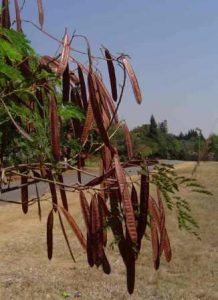
Leucaena leucocephala pods and leaves. Photo : Bart Wursten. Flora of Zimbabwe
•Leucaena leucocephala has been widely introduced as a source of timber, fuelwood, fodder and shade and is also used to restore degraded lands, improve soils and stabilize sands. Leucaena is a fast-growing, nitrogen-fixing tree that is tolerant of arid conditions and saline soils and thus is highly regarded in arid regions in Asia and Africa. In areas where it has been introduced, however, this species tends to form dense impenetrable thickets and readily invades forest margins, roadsides, wastelands, riparian areas and agricultural lands. Also, the toxicity of its seeds and foliage decreases its value as a source of fodder.
• Prosopis juliflora, introduced 70 years ago in the Thar Desert of India, has dense green vegetation which is useful in controlling soil erosion, reducing the aridity of the area, and providing a source of fuelwood as well as fodder and shelter for both wild and domesticated animals. Such benefits however are being overshadowed by the negative impacts of this species. P. juliflora displaces native flora resulting in reduced biodiversity and reduced diversity of products available to rural communities. Its dense impenetrable thickets also render invaded lands useless for agricultural purposes.
• Salt cedar (Tamarix spp.), introduced from central Asia to the southwestern United States nearly 200 years ago to control erosion along river banks, now forms dense thickets on more than 400 000 ha of riparian habitat, severely impacting hydrological systems.
It is vital to ensure that such species serve the purposes for which they were introduced and do not escape to cause negative consequences in native ecosystems.
-Beverly A. Moore Forest Resources Division Food and Agriculture Organization, Rome, Italy


